Here is the process I used to cook a "hot & fast" barbequed beef brisket. Brisket is generally more than a little initimidating for those that have never cooked one. I know that was the case for me back in the day.
For those uninitiated, the brisket is a very tough cut found on the chest of the animal, between and behind the front legs (foreshank). Cattle walk a lot, so the front legs get a good workout. After one look at a brisket you will see that it looks like a cow's odometer. It's long and hard, like the third grade.
Tough "lesser cuts" are generally what barbeque is all about. A tough cut usually equates to a tough (long and slow) cook, but that need not be the case. This brisket was my first attempt at cooking hot and fast. The results have me scratching my head wondering why I've been torturing myself with 16-hour cooks (low & slow means about 1 - 1 ½ hours per pound).
When shopping for a brisket, you want a "whole packer". This is really two cuts in one. The pointy thicker end is called the "point" (or "deckle") and the long flat portion is called, you guessed it, the "flat".
Look for a packer in the 13-16 pound range with a flat that is fairly consistent in thickness, and with a nice white fat cap. The white fat indicates that the animal was finished on grain instead of grass. You should also check to make sure that it's flexible. As a general rule, the more flexible it is in the bag, the more tender it will be in the end. I drape mine over my forearm and look for a nice bend.
For a little different twist, you can marinate the brisket in a double batch of Patio Daddio Bovine Bath then drain and use the slather and seasoning process in step 5 below.
As always, click the image to see a larger version.
Ingredients
1 whole Packer brisket (13-16 lbs)
1/4 cup Prepared mustard (I use French's)
2/3 cup of your favorite BBQ seasoning
Method
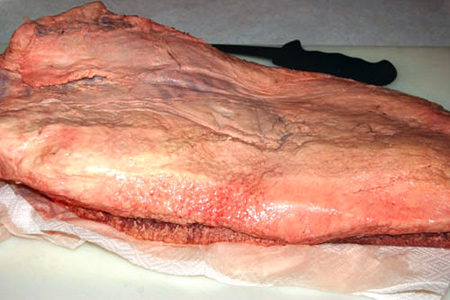
Remove the brisket from the cryovac bag, rinse well with cold water and pat dry. Put it on the cutting board fat-side-up on a double layer of paper towels. This brisket was 15 ½ pounds in the bag. I like to use a 6-inch flexible boning knife for trimming. You'll see why as we progress through the process.
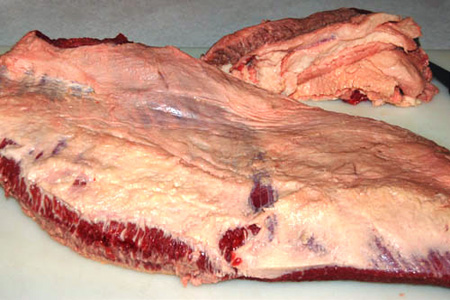
The first order of business in trimming is to shave the fat layer down to a reasonable thickness. Seasoning and smoke can't penetrate fat. However, it will act as an insulation layer to protect the meat when we cook it. I try to get it to about ¼-inch, but you can see it's an inexact science.
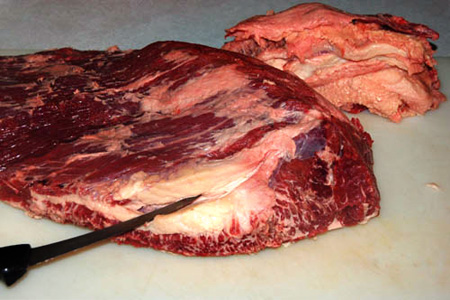
Flip the brisket over and you'll notice two pockets or "kernels" of hard fat. These separate the flat and point muscles. Fat equals flavor and tenderness, but we don't need it all. Cut about ¾ of the fat out of the smaller kernel where you see the knife point.
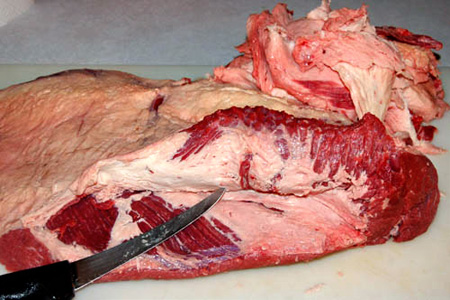
Turn the brisket around and repeat the same trimming process for the large kernel. I like to make a long horizontal cut through the fat then make two long deep angular cuts from each outside edge toward the first cut. You can see this where the knife is pointing. I was a little over-aggressive in my trimming.
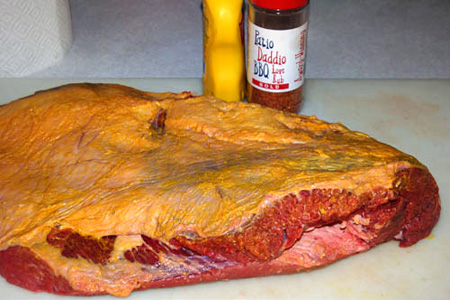
You can see from the pile of trimmings in the background of the picture above that I removed about 1 ½ pounds. In my experience, that's pretty typical. Now we need to smear a thin layer of mustard on all of the outer surfaces (edges too) and inside each fat kernel pocket. This will help the seasoning adhere.
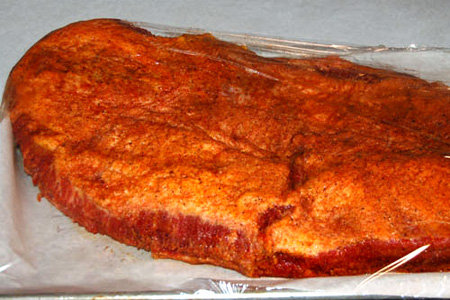
Season the entire surface and fat kernel pockets liberally with your seasoning. You don't need to rub it into the meat, but I pat it when I'm done to make sure it all sticks. Put the brisket on parchment paper in a large a sheet pan, cover with plastic wrap, and refrigerate overnight, or at least several hours.
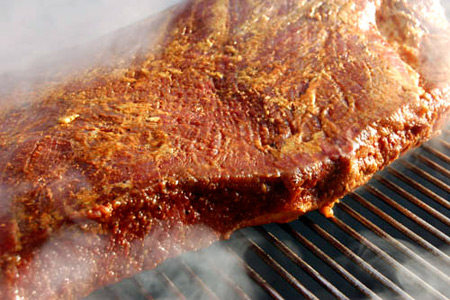
Start your fire and prepare for indirect cooking at medium-high heat. I recommend a mixture of cherry and hickory chunks or chips for smoke. Cook fat-side-down at 325-350º until the thickest part of the flat reaches 190º. Mine (about 14 pounds trimmed) took 5 hours at an average of 350º.
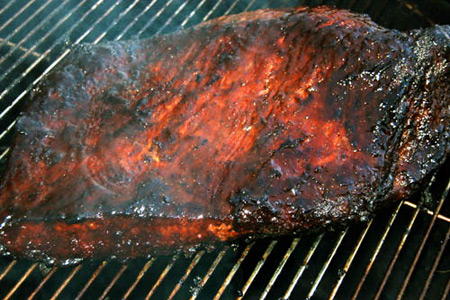
At 190º we're ready to apply the finishing glaze. I use a mixture of ½ cup golden brown sugar, ½ cup beef broth, ¼ cup ketchup, 1 Tbsp Worcestershire, and 1 tsp black pepper. Spoon and spread this (with the back of the spoon) on all sides and dust with the BBQ seasoning. Cook 30 more minutes and repeat.
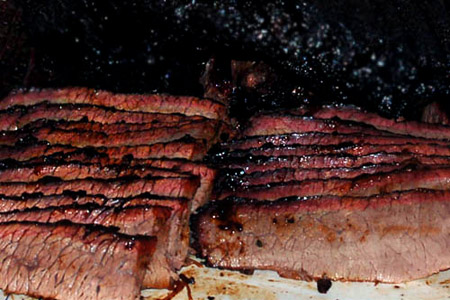
Continue cooking until the thickest part of the flat reaches 200º. Remove from the cooker, wrap in a double layer of heavy-duty foil and let rest 30 minutes (or longer wrapped in towels). Unwrap, separate the flat and point (it's easy), slice across the grain about ¼" thick, serve and enjoy.
Notes:
The entire cook took exactly 6 hours in my homemade drum cooker (UDS), but your mileage may (and almost certainly will) vary.
I used the new Kingsford Competition Briquets for this cook. It's the first time that I've had a chance to use them.
Does 200.F get the meat as broken down as it needs to be for competition?
ReplyDeleteI have read where people are suggesting 210... What are your thoughts?
200-205* works fine for me. -John
ReplyDeletesince your using your UDS so you have to use a diffuser to make it "indirect" or is the 24 or so inch separation between the coals and cooking grate enough to be considered indirect cooking? Thanks
ReplyDeleteAs for using a diffuser, I do both. I have one "plain" two-rack UDS, and another that is what I call a USM (Ugly Smokey Mountain). It has the same two cooking racks, plus a third for a water pan.
ReplyDeleteI use the plain one for short cooks (ribs and chicken in competition), and the USM for long cooks (brisket and butts).
I love the old-school flavor that a UDS imparts, but it can quicky become way too much during long cooks.
I have and uds and I find it hard to get longer cooks with it. What are some fire methods you use when cooking in your uds. I am still trying to find my niche when building my fire.
ReplyDeleteRyan from Texas
I use the "Minion method" and a water pan. The coals last a very long time, and the water pan helps avoid flare-ups that can cause a hot burn.
ReplyDeleteTried it this weekend and it was great, I am too scratching my head as to why I ever did overnight long brisket cooks. I used your finishing glaze and all. Perfect
ReplyDeleteI have always enjoyed your detailed posts on the Brethren and appreciate your contribution to the BBQ world. Thanks!
Not sure what the magic behind this is, have tried cooking brisket (12-13 lbs packers cut) fat side up in indirect heat (200-225F) for 10-11 hrs, and when checked it is still 160F. Is it because you went to 350F with fat side down?
ReplyDeleteAnonymous - What you have described is what we call "the plateau", or "the stall". It happens in large cuts (pork shoulders/butts and brisket) typically in the 160-170* range, although I've seen it happen at 140-150*.
ReplyDeleteThe temperature literally plateaus or stalls in that range, and it can take hours for the temperature to start rising again. This is completely normal. You just have to be patient and keep cooking.
Cooking hotter and faster as I do does shorten the stall period, but it's still there.
I hope this helps.
I built a great running UDS, and am installing a lower grate today, with firebricks on it as a diffuser, for a 13# brisket cooking tonight/tomorrow.
ReplyDeleteI've done brisket before on my offset, and sweet baby Jesus, took 18 hours; lot of work. My UDS will easily do 18 hours @ 225 on 16ish# of briquettes.
Sorry for that, but my question is, have you done a "split the difference" brisket cook, ie, 275-290ish?
Thanks, nice post.
Jack, Mokena, IL
Yes, I've cooked in the mid temperature range before. I don't find that it really affects the cook, so I opt for the time savings of the higher temp.
ReplyDeleteI did two 10 pound pork shoulders this weeknd and hit the stall at 160 - 165 degrees fo over 2 1/2 hours, cooking at 225 - 250 degrees.
ReplyDeleteAfter 2 1/2 hours of stall and getting nervous about having the food done in time, I boosted the heat to 325 - 350 degrees, broke the stall in about a half hour, and hit 195+ internal in about 1 1/2 to 2 hours. The boost in the heat didn't affect the quality of the shoulders in the end either. I have pictures
Great step by step post! Thanks, gonna try ur method tomorrow. Question: if u leave it wrapped in foil too long, does it dry out? I've wrapped in foil before and the brisket is either too dry or overcooked, falls apart like pot roast.
ReplyDeleteAlex - Leaving it wrapped too long will produce the overcooked pot roast-like results you described.
ReplyDeleteTried this exact method yesterday and it came out looking and tasting better than I had expected. It was really difficult to tell the difference from a low'n'slow cook. I highly recommend this way of doing it for anyone who ants to cut their cooking time in half.
ReplyDeletehttp://i56.tinypic.com/rlvts8.jpg
What kind of smoker are you using. I have a water/propane smoker, and it seems that if I use the water bowl, my smoker won't hit those higher temps (due to the water).
ReplyDeleteFD - I generally use my Ugly Drum Smoker (UDS). You are right that the water pan inhibits high temps, as it's intended to be a heat sink.
ReplyDeleteCan you do this with just the flat?
ReplyDeleteare you cooking with this method in competitions
ReplyDeleteJason - I do cook my competition brisket hot & fast, but I use a different recipe nowadays.
ReplyDeleteSo no foil while cooking? I'll have to give this a try, since I've always foiled with HnF. And I haven't liked the bark at all.
ReplyDeleteBravo
ReplyDeleteYes... girl here, I cook my 12lber in a normal oven at 350 for 6hrs put in pit to smoke smoke about 1hr, put foil and back in the pit for 1hr. Just put Vageta seasoning with Lawrys Garlic salt and black pepper, comes out great, not competition or any thing but tender and yummy... yall should try using Vagetta as a rub...
ReplyDeleteAnother method I've used at the 325-350 range is to foil it at 170 (about 2 hours) and cook for another 2 hours. Don't worry about temp, simply insert your thermometer and if it goes in with little resistance, it's ready. Let it rest for about 30 minutes, slice and serve. People love it - it's fork tender.
ReplyDelete